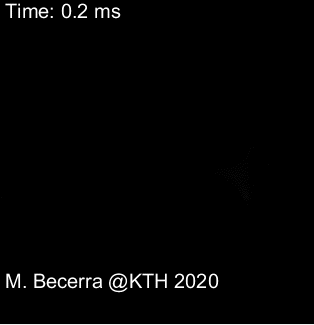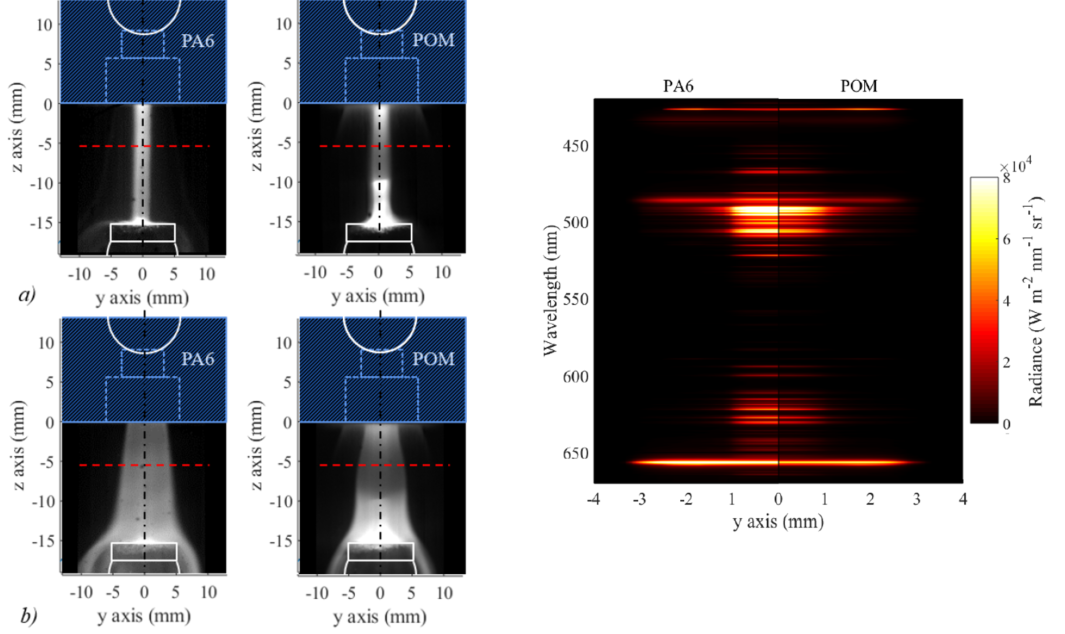High Current Arc Plasmas Controlled by Polymer Ablation
Understanding the interaction of thermal plasmas with polymer surfaces
The purpose of this project is to improve the existing knowledge on the fundamental physical, chemical aspects of the vapour generation (also referred to as ablation) of polymers exposed to thermal arc plasmas and their interaction. Even though ablation of polymers with lasers has been broadly investigated in the last two decades, little is known about this process under the broad-band spectral radiation generated by electrical arcs in air. Since ablating polymers have gradually been used to control and/or quench electrical arcs in a number of applications such as electrical fuses, circuit breakers, soft x-rays, pulse plasma thrusters and extreme UV sources, the basic research in this field is an increasing need for the further development of those technologies. The two videos below show examples of high-current electric arcs formed by two plasma jets of metal vapor from evaporation of copper electrodes. Those two plasma jets are influenced by the ablation of a polymer.


The study of arc plasmas controlled by polymer ablation requires of multidisciplinary research in plasma physics, polymer chemistry, radiation science, plasma diagnostics and material science. Different aspects studied in our research are:
- Radiation emission by thermal arc plasmas dominated by copper and polymer vapours: radiation is a major mechanism of energy transfer from the arc plasma into polymers. Thus, plasma diagnostics using high speed photography and optical emission spectroscopy have been used to characterize the radiation from ablation-controlled arcs. The figures below show an example of the differences in brightness and radiance In the high-speed image below one can see the differences in emission from copper and hydrogen lines using two different types of polymeric nozzles. For additional details, follow the link

- Interaction between radiation and polymeric materials: The optical properties of the bulk material are also key to estimate the amount of radiated energy absorbed by the ablating polymer and the heating it produces. The incoming radiation however interacts with the polymer bulk and with the near-surface layer of ablated polymer fragmetns in different ways due absorption, reflection and scattering of light. We have found out that the absorption coefficient of polymers change strongly with temperature and therefore estimates of the arc-induced temperature increase in the polymer bulk should not use directly data from spectrophotometric measurements at room temperature. Furthermore, band-averaged optical properties of polymers exposed to the broadband arc radiation (from UV-C to SW-IR) have been estimated based on in-situ radiation measurements. Additional details about the interaction of radiation with the polymer and with the ablation layer can be found in the link here and here .

- Characterization of degradation fragments released by arc-induced ablation of polymers in air: When polymers are ablated, they degrade and release fragments which interact with the incoming radiation and define the flux of material into the arc environment. For the first time, mass spectra of degradation fragments produced by arc-induced ablation have been obtained from the material deposited on the substrates by using laser desorption ionization time-of-flight mass spectrometry (LDI-ToF-MS). More details are available in this link .

This project has been performed with multidisciplinary cooperation with ABB and with the Leibnitz Institute of Plasmas INP in Greifswald, Germany, aimed to improve the performance of electrical switching devices (e.g. breakers, contactors) in low voltage applications by using polymeric ablating materials.
På svenska: Ablation av polymerer: fysik, kemi och effekterna på ljusbågar i luft

